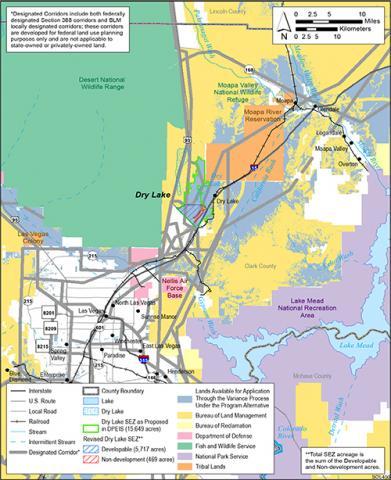Nevada’s Dry Lake sets good model for solar energy on public lands

Kevin Harber-Flickr
Bureau of Land Management approves three new solar projects in a designated solar energy zone 20 miles from Las Vegas.
The Department of Interior (DOI) and Bureau of Land Management (BLM) set a precedent for smart solar energy in a recent decision to approve three large-scale solar projects in the Dry Lake Solar Energy Zone of southern Nevada. These projects represent a significant step in securing a clean energy future for our nation without compromising our natural heritage in the process.
Solar energy zones are places that have been identified as suitable for solar development with minimal impacts on wildlands and wildlife habitat. The recently approved Dry Lake projects are the first to be auctioned and approved in one of these designated areas, marking a major success story for the Western Solar Plan.

Combined, the Dry Lake projects will generate up to 440 megawatts, enough energy to power over 100,000 homes, helping meet the Department of Interior's goal to approve 20,000 megawatts of pollution-free renewable energy by 2020.
Choosing smart places for solar energy development
Located in southern Nevada, the Dry Lake Solar Energy Zone covers roughly 3,000 acres of lands that have already been impacted by development. Lands within and around Dry Lake contain multiple transmission lines, several power plants and other industrial facilities, mining operations, several major highways and a railroad.
Guiding energy projects to areas that have already been impacted by development steers them away from sensitive wild places. Additionally, developers can save resources by using existing infrastructure such as roads and power lines. This approach is more practical than developing infrastructure from scratch in areas that provide habitat for wildlife and opportunities for quiet recreation.
Dry Lake as an example of an area primed for development
Utilizing solar energy represents a newer, smarter approach to energy development on public lands, and solar energy zones are the most appropriate places for their development. Several factors contributed to the approval of projects in the Dry Lake Solar Energy Zone, including the following:
- Location – the Western Solar Plan identified low-conflict, pre-screened zones near existing roads and transmission lines for solar development, including Dry Lake.
- Permitting time – developing renewable energy in these pre-designated zones is quicker. The solar projects at Dry Lake were approved in half the average time of previous solar energy projects on public lands.
- Mitigation planning – the Bureau of Land Management established a Solar Regional Mitigation Strategy for Dry Lake, which offers more certainty for developers on mitigation costs and better conservation outcomes from investment of funds for conservation offsets to preserve and restore other lands in the region.
The future of energy development on public lands
Success doesn’t stop at Dry Lake. The Wilderness Society would like to see continued development of projects in solar energy zones to ensure that we meet our clean energy goals while avoiding negative impacts to wild places.
Building off the success of this project, DOI and BLM can ensure that other solar energy zones and designated areas are primed for development. The agency can take the following steps to keep momentum heading in the right direction:
- Complete regional mitigation strategies for the other 18 solar energy zones in order to streamline the permitting process.
- Continue to find the right places for development of wind, solar, geothermal and transmission projects.
- Finalize a rulemaking for wind and solar leasing, which will establish a long-term approach to development that incentivizes projects in low-conflict areas.
